SBM3304 Accounting Theory - Environmental Sustainability & Long Term
VerifiedAdded on 2023/06/13
|9
|2585
|414
Essay
AI Summary
This essay discusses the critical importance of long-term environmental sustainability for both social and economic sustainability, drawing on various sources to define sustainability and highlight its core components: economic development, social development, and environmental protection. It emphasizes that economic sustainability involves production systems that meet current needs without compromising future generations, while social sustainability focuses on alleviating poverty and preventing resource exploitation. The essay further explores the role of environmental sustainability in maintaining natural capital and the need for long-term planning to protect ecosystems, improve air quality, and promote resource integrity. Ultimately, the essay concludes that integrating environmental, economic, and social sustainability is essential for achieving a balanced and sustainable future for human society. Desklib offers a wealth of similar academic resources for students.
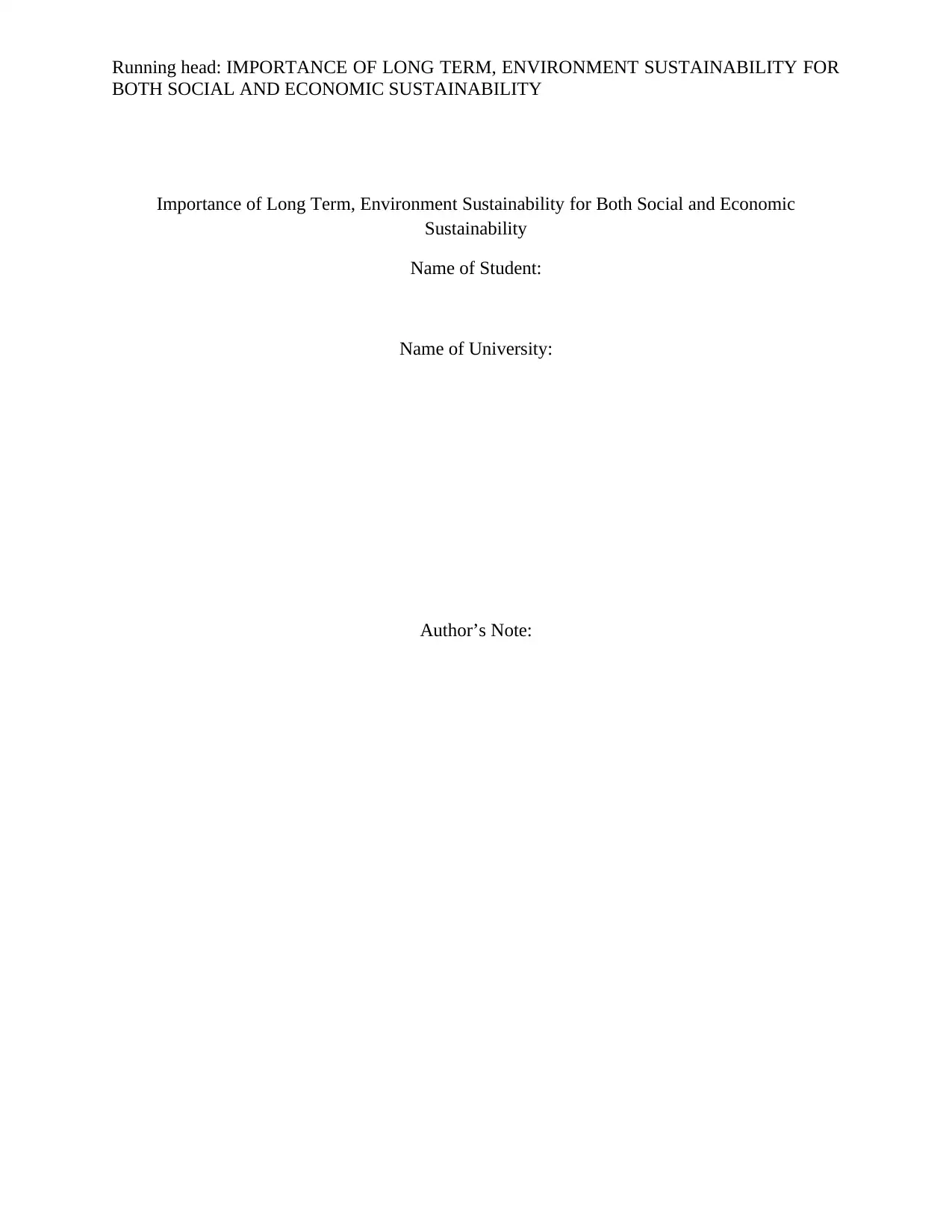
Running head: IMPORTANCE OF LONG TERM, ENVIRONMENT SUSTAINABILITY FOR
BOTH SOCIAL AND ECONOMIC SUSTAINABILITY
Importance of Long Term, Environment Sustainability for Both Social and Economic
Sustainability
Name of Student:
Name of University:
Author’s Note:
BOTH SOCIAL AND ECONOMIC SUSTAINABILITY
Importance of Long Term, Environment Sustainability for Both Social and Economic
Sustainability
Name of Student:
Name of University:
Author’s Note:
Paraphrase This Document
Need a fresh take? Get an instant paraphrase of this document with our AI Paraphraser
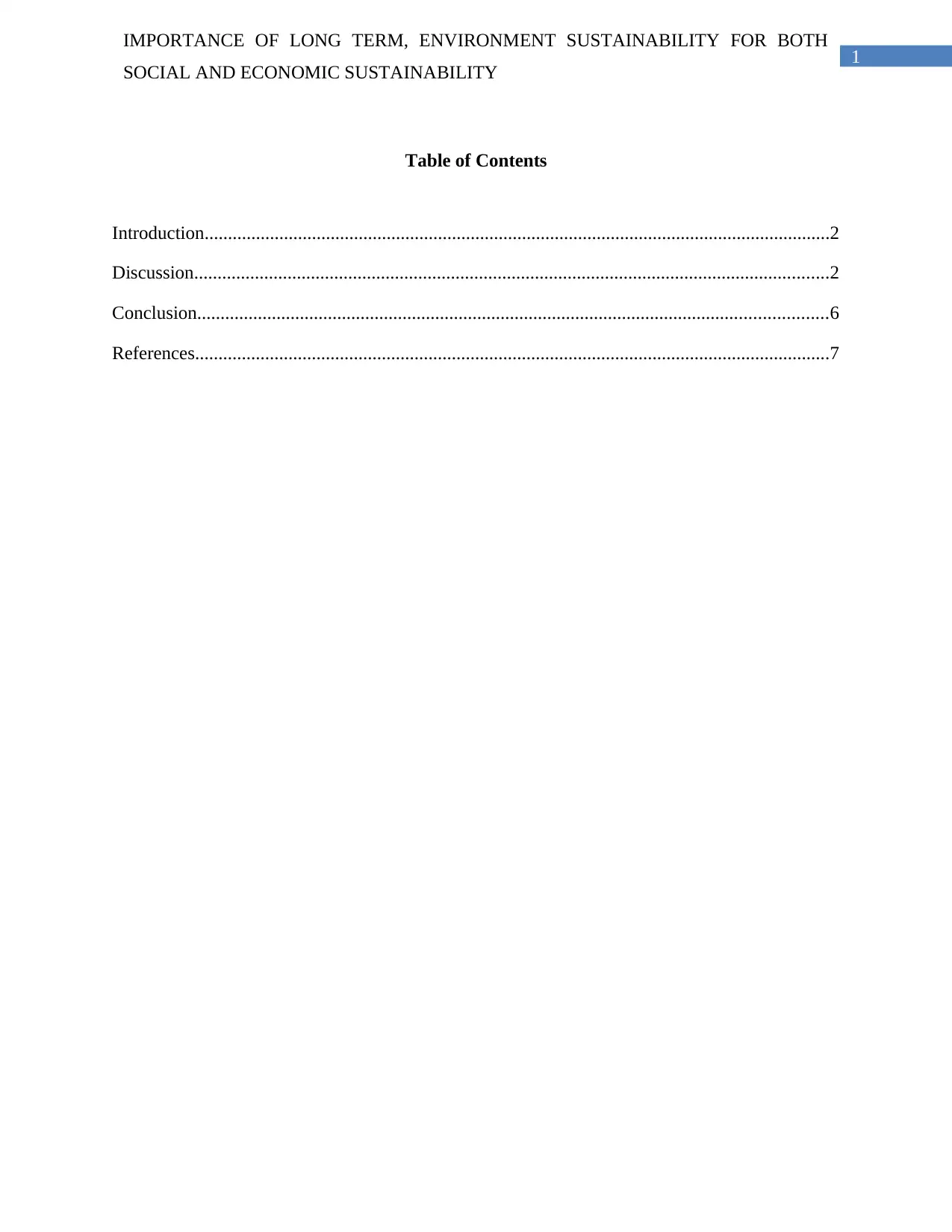
1
IMPORTANCE OF LONG TERM, ENVIRONMENT SUSTAINABILITY FOR BOTH
SOCIAL AND ECONOMIC SUSTAINABILITY
Table of Contents
Introduction......................................................................................................................................2
Discussion........................................................................................................................................2
Conclusion.......................................................................................................................................6
References........................................................................................................................................7
IMPORTANCE OF LONG TERM, ENVIRONMENT SUSTAINABILITY FOR BOTH
SOCIAL AND ECONOMIC SUSTAINABILITY
Table of Contents
Introduction......................................................................................................................................2
Discussion........................................................................................................................................2
Conclusion.......................................................................................................................................6
References........................................................................................................................................7
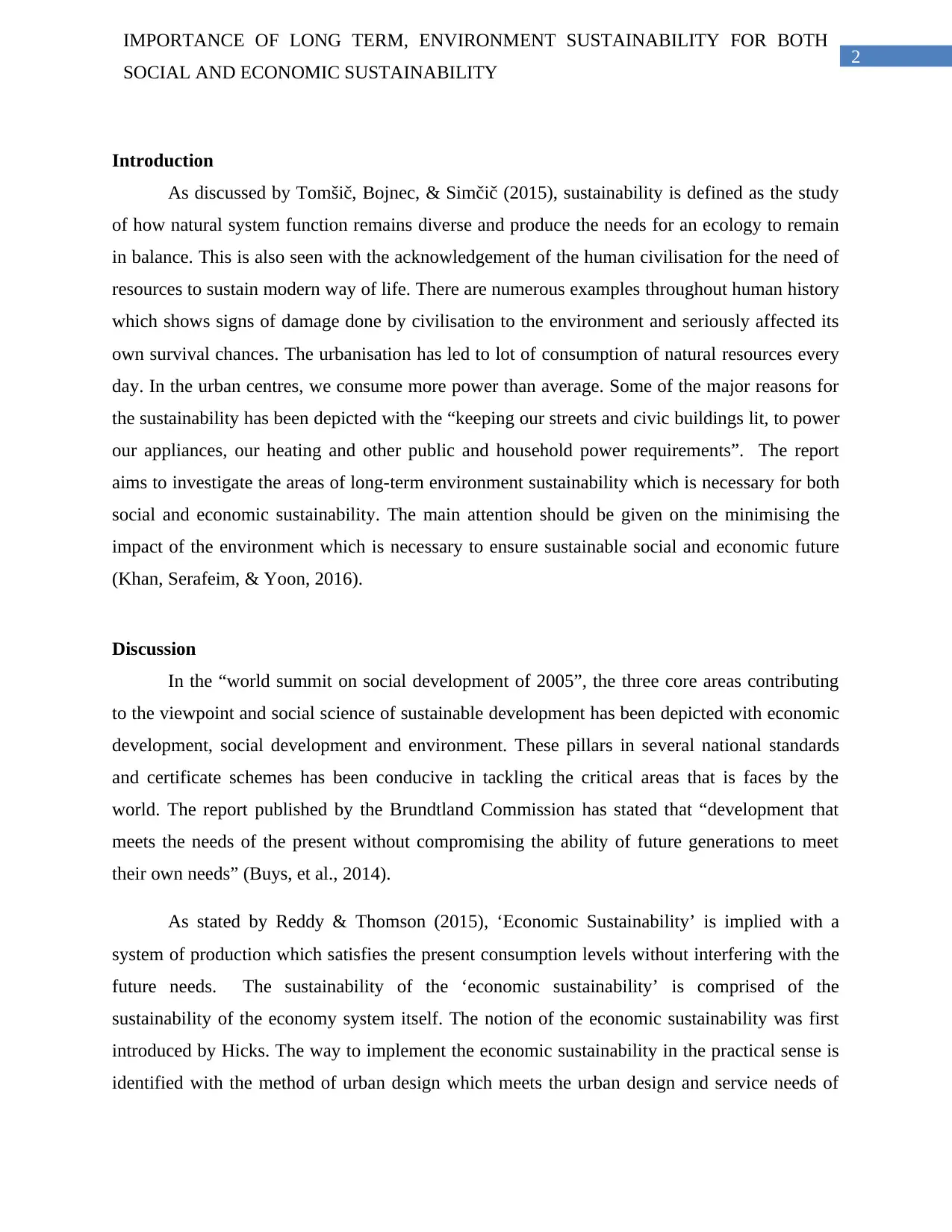
2
IMPORTANCE OF LONG TERM, ENVIRONMENT SUSTAINABILITY FOR BOTH
SOCIAL AND ECONOMIC SUSTAINABILITY
Introduction
As discussed by Tomšič, Bojnec, & Simčič (2015), sustainability is defined as the study
of how natural system function remains diverse and produce the needs for an ecology to remain
in balance. This is also seen with the acknowledgement of the human civilisation for the need of
resources to sustain modern way of life. There are numerous examples throughout human history
which shows signs of damage done by civilisation to the environment and seriously affected its
own survival chances. The urbanisation has led to lot of consumption of natural resources every
day. In the urban centres, we consume more power than average. Some of the major reasons for
the sustainability has been depicted with the “keeping our streets and civic buildings lit, to power
our appliances, our heating and other public and household power requirements”. The report
aims to investigate the areas of long-term environment sustainability which is necessary for both
social and economic sustainability. The main attention should be given on the minimising the
impact of the environment which is necessary to ensure sustainable social and economic future
(Khan, Serafeim, & Yoon, 2016).
Discussion
In the “world summit on social development of 2005”, the three core areas contributing
to the viewpoint and social science of sustainable development has been depicted with economic
development, social development and environment. These pillars in several national standards
and certificate schemes has been conducive in tackling the critical areas that is faces by the
world. The report published by the Brundtland Commission has stated that “development that
meets the needs of the present without compromising the ability of future generations to meet
their own needs” (Buys, et al., 2014).
As stated by Reddy & Thomson (2015), ‘Economic Sustainability’ is implied with a
system of production which satisfies the present consumption levels without interfering with the
future needs. The sustainability of the ‘economic sustainability’ is comprised of the
sustainability of the economy system itself. The notion of the economic sustainability was first
introduced by Hicks. The way to implement the economic sustainability in the practical sense is
identified with the method of urban design which meets the urban design and service needs of
IMPORTANCE OF LONG TERM, ENVIRONMENT SUSTAINABILITY FOR BOTH
SOCIAL AND ECONOMIC SUSTAINABILITY
Introduction
As discussed by Tomšič, Bojnec, & Simčič (2015), sustainability is defined as the study
of how natural system function remains diverse and produce the needs for an ecology to remain
in balance. This is also seen with the acknowledgement of the human civilisation for the need of
resources to sustain modern way of life. There are numerous examples throughout human history
which shows signs of damage done by civilisation to the environment and seriously affected its
own survival chances. The urbanisation has led to lot of consumption of natural resources every
day. In the urban centres, we consume more power than average. Some of the major reasons for
the sustainability has been depicted with the “keeping our streets and civic buildings lit, to power
our appliances, our heating and other public and household power requirements”. The report
aims to investigate the areas of long-term environment sustainability which is necessary for both
social and economic sustainability. The main attention should be given on the minimising the
impact of the environment which is necessary to ensure sustainable social and economic future
(Khan, Serafeim, & Yoon, 2016).
Discussion
In the “world summit on social development of 2005”, the three core areas contributing
to the viewpoint and social science of sustainable development has been depicted with economic
development, social development and environment. These pillars in several national standards
and certificate schemes has been conducive in tackling the critical areas that is faces by the
world. The report published by the Brundtland Commission has stated that “development that
meets the needs of the present without compromising the ability of future generations to meet
their own needs” (Buys, et al., 2014).
As stated by Reddy & Thomson (2015), ‘Economic Sustainability’ is implied with a
system of production which satisfies the present consumption levels without interfering with the
future needs. The sustainability of the ‘economic sustainability’ is comprised of the
sustainability of the economy system itself. The notion of the economic sustainability was first
introduced by Hicks. The way to implement the economic sustainability in the practical sense is
identified with the method of urban design which meets the urban design and service needs of
⊘ This is a preview!⊘
Do you want full access?
Subscribe today to unlock all pages.

Trusted by 1+ million students worldwide

3
IMPORTANCE OF LONG TERM, ENVIRONMENT SUSTAINABILITY FOR BOTH
SOCIAL AND ECONOMIC SUSTAINABILITY
the public. This is mainly evident in case of urban poor, during the enhancement of the
naturalness of the urban environment (Diaz-Chavez, 2014).
The economic sustainability is understood with the exercise of sustainability and
sustainable design from an intelligent and creative use of the economic resources. The main
learnings strive to understand the various type the requirements are seen to be based on creating
appropriate value of the intervention which is much higher than the price. The sustainability
aspect has been further related to the various types of the aspects which are related to the
sustainable development defending the smart and strategic management of budgets. It has been
further considered as the decision to consider rational consumption of the achievable sustainable
development (Mutisya & Yarime, 2014).
The main issues pertaining to the economic development is able to prove that in many
instances the people disagrees to the political ideology and the way it affects the business. This is
seen to be based on the extensions, jobs and employability. The importance of economic
development is also discerned with providing more incentives to the business and other
organisations for adhering to the sustainability guidelines beyond the normal legislation
requirements. The main objective of the economic development is also seen with the fostering
the incentives for the average person to do best on their part in the main areas of the business
(Yadava & Sinha, 2016). The supply and demand market is identified with the supply and
demand to be consumerist in modern life thereby requiring a lot of resources in every single day.
Economic development is about providing the people what they desire without compromising
with the quality of life especially in the developing world and reducing the overall financial
burden.
Social sustainability is considered with the alleviation of the sustained poverty levels and
prevention of natural resource exploitation. The international development organization
considered by World Bank and International development organization is seen to be financed by
the World Bank and the International Monetary Fund, with an aim to focus on the significant
improvements in terms of the “developing nations to better their economic conditions, including
roads, power plants, and hydroelectric dams”. The different types of the consequences of the
social and environmental approach has been embodied in the “Third World debt crisis” and
IMPORTANCE OF LONG TERM, ENVIRONMENT SUSTAINABILITY FOR BOTH
SOCIAL AND ECONOMIC SUSTAINABILITY
the public. This is mainly evident in case of urban poor, during the enhancement of the
naturalness of the urban environment (Diaz-Chavez, 2014).
The economic sustainability is understood with the exercise of sustainability and
sustainable design from an intelligent and creative use of the economic resources. The main
learnings strive to understand the various type the requirements are seen to be based on creating
appropriate value of the intervention which is much higher than the price. The sustainability
aspect has been further related to the various types of the aspects which are related to the
sustainable development defending the smart and strategic management of budgets. It has been
further considered as the decision to consider rational consumption of the achievable sustainable
development (Mutisya & Yarime, 2014).
The main issues pertaining to the economic development is able to prove that in many
instances the people disagrees to the political ideology and the way it affects the business. This is
seen to be based on the extensions, jobs and employability. The importance of economic
development is also discerned with providing more incentives to the business and other
organisations for adhering to the sustainability guidelines beyond the normal legislation
requirements. The main objective of the economic development is also seen with the fostering
the incentives for the average person to do best on their part in the main areas of the business
(Yadava & Sinha, 2016). The supply and demand market is identified with the supply and
demand to be consumerist in modern life thereby requiring a lot of resources in every single day.
Economic development is about providing the people what they desire without compromising
with the quality of life especially in the developing world and reducing the overall financial
burden.
Social sustainability is considered with the alleviation of the sustained poverty levels and
prevention of natural resource exploitation. The international development organization
considered by World Bank and International development organization is seen to be financed by
the World Bank and the International Monetary Fund, with an aim to focus on the significant
improvements in terms of the “developing nations to better their economic conditions, including
roads, power plants, and hydroelectric dams”. The different types of the consequences of the
social and environmental approach has been embodied in the “Third World debt crisis” and
Paraphrase This Document
Need a fresh take? Get an instant paraphrase of this document with our AI Paraphraser

4
IMPORTANCE OF LONG TERM, ENVIRONMENT SUSTAINABILITY FOR BOTH
SOCIAL AND ECONOMIC SUSTAINABILITY
environment deterioration brought by the construction of the large projects which was evident
from the 1980s.
The sustainability development science has been taken into account with the planners of the
development science to apply the evolving notions of the sustainability in the contemporary
debate over how cities and regions needs to be reformed, revitalised and redeveloped. The
concept of sustainability is regarded with the alternatives pertaining to the means of urban
development. In the recent time, it has been common for the planners to describe the efforts to
reverse the various type of the issues related to the urban sprawl, congestion and declining nature
of urban sustainability. This consideration is evident even though there is no consensus existing
with the human settlement embodying sustainability. The urban sustainability is implied with the
“quality of life of its citizens, or the capacity of nature to support its activities”. The reach of
economic sustainability of a city is seen with the potential of attaining quantitative aspects to a
new level of the socio-economic, technological and demographic output (Cooper, Stamford, &
Azapagic, 2016).
It needs to be further understood that the theory of social sustainability calls for the
economic growth which is constrained with the various requirement as per the social equity. The
linking of the environment elements needs to be considered with the different types of the factors
which are associated to optimization of the environment, optimization of the resources and
prioritizing the resource allocation. This has been further able to taken into consideration for the
fostering of the equitable resource distribution. In several types of the empirical evidence it has
been suggested that the environment sustainability is necessary for the precondition of the
sustained economic growth. It is further seen that in several situations the U.S. has been takin
several types of the initiatives which are focused on the sustainable growth. There have been
several facets of the social development pillar. The most important form of the developmental
factor is considered with the awareness of the legislation protection of the health of people from
pollution and various type the harmful activities of the business and other organisations. In
“North America, Europe and the rest of the developed world”, there has been strong checks on
the programs of the legislation to ensure people health is taken care with highest priority. The
social sustainability is also relevant to the maintaining the basic resources without compromising
IMPORTANCE OF LONG TERM, ENVIRONMENT SUSTAINABILITY FOR BOTH
SOCIAL AND ECONOMIC SUSTAINABILITY
environment deterioration brought by the construction of the large projects which was evident
from the 1980s.
The sustainability development science has been taken into account with the planners of the
development science to apply the evolving notions of the sustainability in the contemporary
debate over how cities and regions needs to be reformed, revitalised and redeveloped. The
concept of sustainability is regarded with the alternatives pertaining to the means of urban
development. In the recent time, it has been common for the planners to describe the efforts to
reverse the various type of the issues related to the urban sprawl, congestion and declining nature
of urban sustainability. This consideration is evident even though there is no consensus existing
with the human settlement embodying sustainability. The urban sustainability is implied with the
“quality of life of its citizens, or the capacity of nature to support its activities”. The reach of
economic sustainability of a city is seen with the potential of attaining quantitative aspects to a
new level of the socio-economic, technological and demographic output (Cooper, Stamford, &
Azapagic, 2016).
It needs to be further understood that the theory of social sustainability calls for the
economic growth which is constrained with the various requirement as per the social equity. The
linking of the environment elements needs to be considered with the different types of the factors
which are associated to optimization of the environment, optimization of the resources and
prioritizing the resource allocation. This has been further able to taken into consideration for the
fostering of the equitable resource distribution. In several types of the empirical evidence it has
been suggested that the environment sustainability is necessary for the precondition of the
sustained economic growth. It is further seen that in several situations the U.S. has been takin
several types of the initiatives which are focused on the sustainable growth. There have been
several facets of the social development pillar. The most important form of the developmental
factor is considered with the awareness of the legislation protection of the health of people from
pollution and various type the harmful activities of the business and other organisations. In
“North America, Europe and the rest of the developed world”, there has been strong checks on
the programs of the legislation to ensure people health is taken care with highest priority. The
social sustainability is also relevant to the maintaining the basic resources without compromising
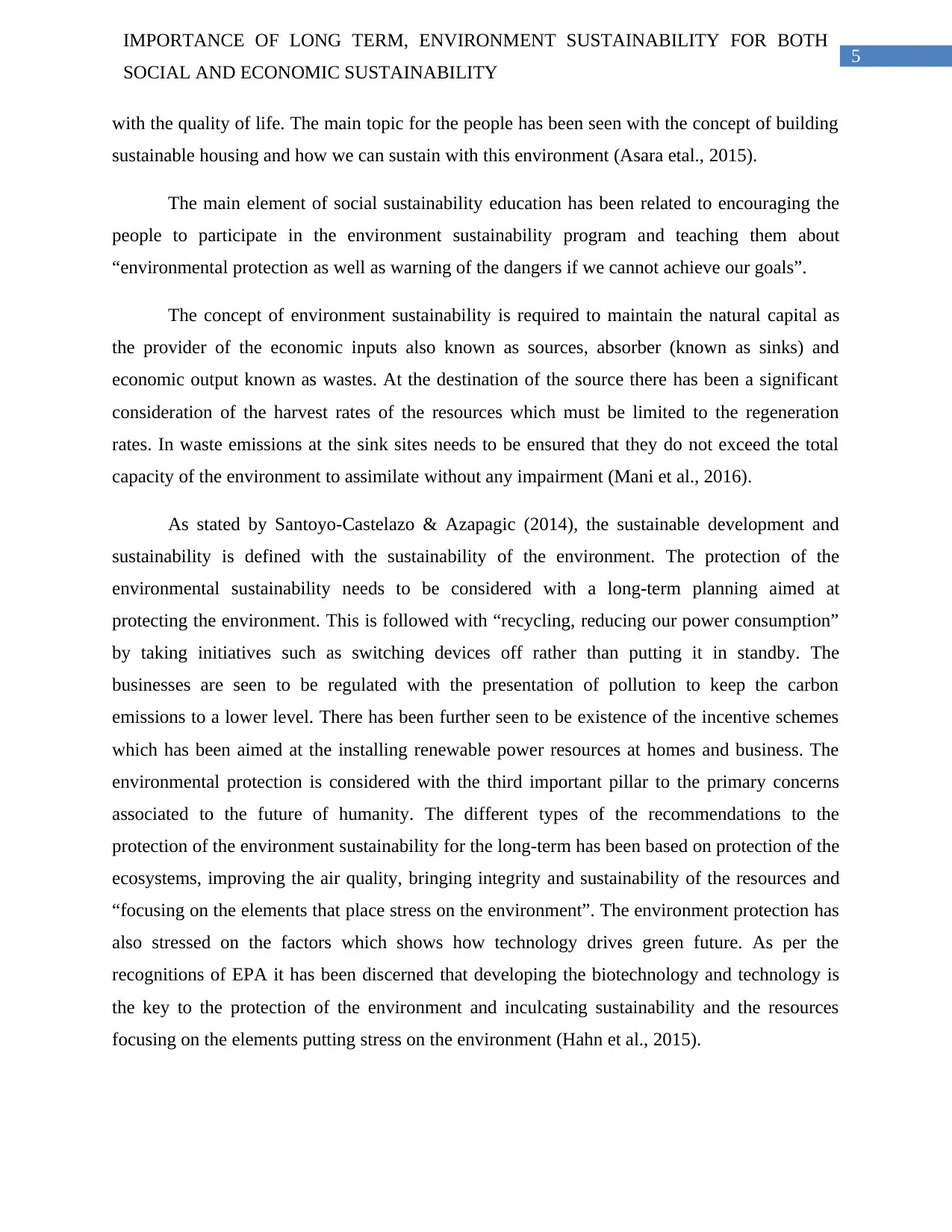
5
IMPORTANCE OF LONG TERM, ENVIRONMENT SUSTAINABILITY FOR BOTH
SOCIAL AND ECONOMIC SUSTAINABILITY
with the quality of life. The main topic for the people has been seen with the concept of building
sustainable housing and how we can sustain with this environment (Asara etal., 2015).
The main element of social sustainability education has been related to encouraging the
people to participate in the environment sustainability program and teaching them about
“environmental protection as well as warning of the dangers if we cannot achieve our goals”.
The concept of environment sustainability is required to maintain the natural capital as
the provider of the economic inputs also known as sources, absorber (known as sinks) and
economic output known as wastes. At the destination of the source there has been a significant
consideration of the harvest rates of the resources which must be limited to the regeneration
rates. In waste emissions at the sink sites needs to be ensured that they do not exceed the total
capacity of the environment to assimilate without any impairment (Mani et al., 2016).
As stated by Santoyo-Castelazo & Azapagic (2014), the sustainable development and
sustainability is defined with the sustainability of the environment. The protection of the
environmental sustainability needs to be considered with a long-term planning aimed at
protecting the environment. This is followed with “recycling, reducing our power consumption”
by taking initiatives such as switching devices off rather than putting it in standby. The
businesses are seen to be regulated with the presentation of pollution to keep the carbon
emissions to a lower level. There has been further seen to be existence of the incentive schemes
which has been aimed at the installing renewable power resources at homes and business. The
environmental protection is considered with the third important pillar to the primary concerns
associated to the future of humanity. The different types of the recommendations to the
protection of the environment sustainability for the long-term has been based on protection of the
ecosystems, improving the air quality, bringing integrity and sustainability of the resources and
“focusing on the elements that place stress on the environment”. The environment protection has
also stressed on the factors which shows how technology drives green future. As per the
recognitions of EPA it has been discerned that developing the biotechnology and technology is
the key to the protection of the environment and inculcating sustainability and the resources
focusing on the elements putting stress on the environment (Hahn et al., 2015).
IMPORTANCE OF LONG TERM, ENVIRONMENT SUSTAINABILITY FOR BOTH
SOCIAL AND ECONOMIC SUSTAINABILITY
with the quality of life. The main topic for the people has been seen with the concept of building
sustainable housing and how we can sustain with this environment (Asara etal., 2015).
The main element of social sustainability education has been related to encouraging the
people to participate in the environment sustainability program and teaching them about
“environmental protection as well as warning of the dangers if we cannot achieve our goals”.
The concept of environment sustainability is required to maintain the natural capital as
the provider of the economic inputs also known as sources, absorber (known as sinks) and
economic output known as wastes. At the destination of the source there has been a significant
consideration of the harvest rates of the resources which must be limited to the regeneration
rates. In waste emissions at the sink sites needs to be ensured that they do not exceed the total
capacity of the environment to assimilate without any impairment (Mani et al., 2016).
As stated by Santoyo-Castelazo & Azapagic (2014), the sustainable development and
sustainability is defined with the sustainability of the environment. The protection of the
environmental sustainability needs to be considered with a long-term planning aimed at
protecting the environment. This is followed with “recycling, reducing our power consumption”
by taking initiatives such as switching devices off rather than putting it in standby. The
businesses are seen to be regulated with the presentation of pollution to keep the carbon
emissions to a lower level. There has been further seen to be existence of the incentive schemes
which has been aimed at the installing renewable power resources at homes and business. The
environmental protection is considered with the third important pillar to the primary concerns
associated to the future of humanity. The different types of the recommendations to the
protection of the environment sustainability for the long-term has been based on protection of the
ecosystems, improving the air quality, bringing integrity and sustainability of the resources and
“focusing on the elements that place stress on the environment”. The environment protection has
also stressed on the factors which shows how technology drives green future. As per the
recognitions of EPA it has been discerned that developing the biotechnology and technology is
the key to the protection of the environment and inculcating sustainability and the resources
focusing on the elements putting stress on the environment (Hahn et al., 2015).
⊘ This is a preview!⊘
Do you want full access?
Subscribe today to unlock all pages.

Trusted by 1+ million students worldwide
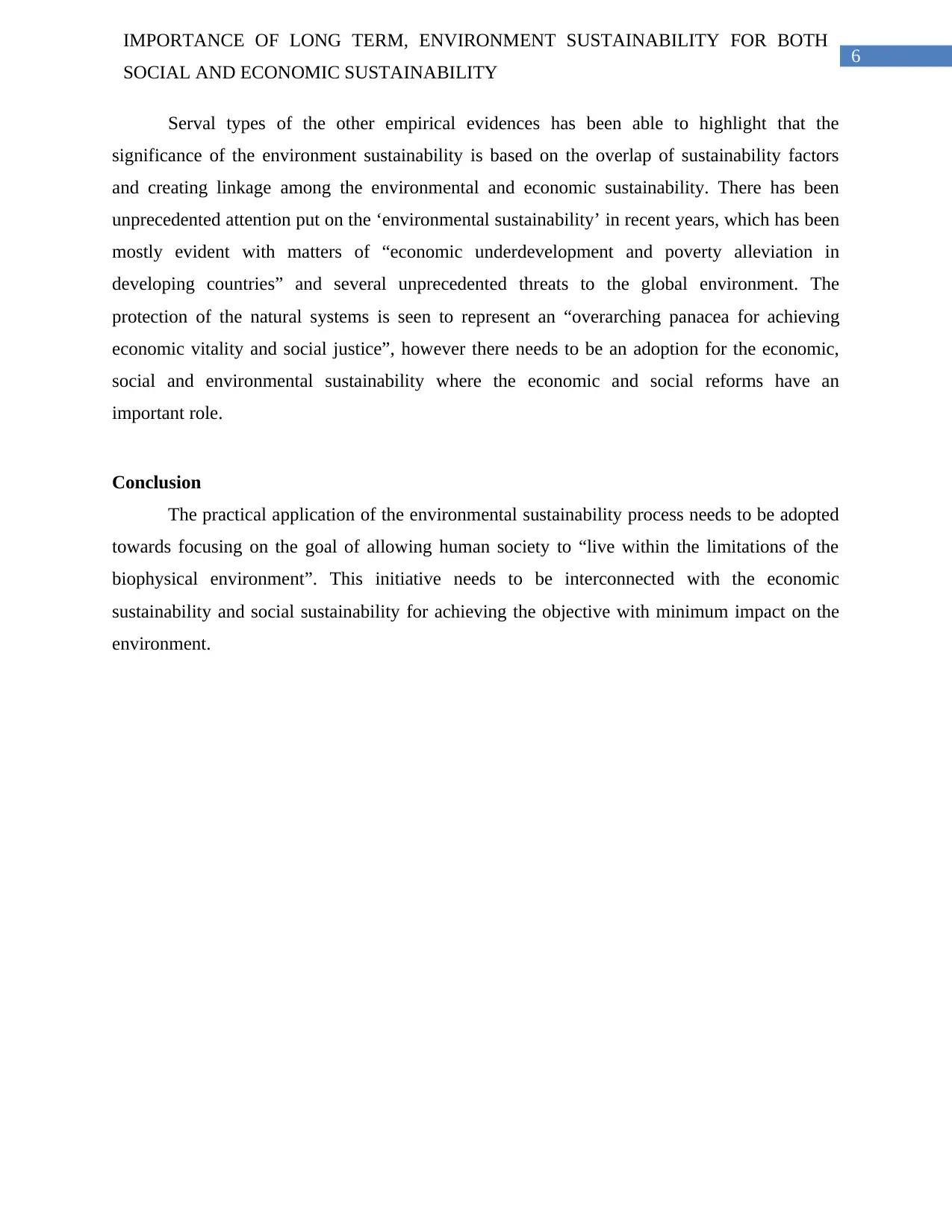
6
IMPORTANCE OF LONG TERM, ENVIRONMENT SUSTAINABILITY FOR BOTH
SOCIAL AND ECONOMIC SUSTAINABILITY
Serval types of the other empirical evidences has been able to highlight that the
significance of the environment sustainability is based on the overlap of sustainability factors
and creating linkage among the environmental and economic sustainability. There has been
unprecedented attention put on the ‘environmental sustainability’ in recent years, which has been
mostly evident with matters of “economic underdevelopment and poverty alleviation in
developing countries” and several unprecedented threats to the global environment. The
protection of the natural systems is seen to represent an “overarching panacea for achieving
economic vitality and social justice”, however there needs to be an adoption for the economic,
social and environmental sustainability where the economic and social reforms have an
important role.
Conclusion
The practical application of the environmental sustainability process needs to be adopted
towards focusing on the goal of allowing human society to “live within the limitations of the
biophysical environment”. This initiative needs to be interconnected with the economic
sustainability and social sustainability for achieving the objective with minimum impact on the
environment.
IMPORTANCE OF LONG TERM, ENVIRONMENT SUSTAINABILITY FOR BOTH
SOCIAL AND ECONOMIC SUSTAINABILITY
Serval types of the other empirical evidences has been able to highlight that the
significance of the environment sustainability is based on the overlap of sustainability factors
and creating linkage among the environmental and economic sustainability. There has been
unprecedented attention put on the ‘environmental sustainability’ in recent years, which has been
mostly evident with matters of “economic underdevelopment and poverty alleviation in
developing countries” and several unprecedented threats to the global environment. The
protection of the natural systems is seen to represent an “overarching panacea for achieving
economic vitality and social justice”, however there needs to be an adoption for the economic,
social and environmental sustainability where the economic and social reforms have an
important role.
Conclusion
The practical application of the environmental sustainability process needs to be adopted
towards focusing on the goal of allowing human society to “live within the limitations of the
biophysical environment”. This initiative needs to be interconnected with the economic
sustainability and social sustainability for achieving the objective with minimum impact on the
environment.
Paraphrase This Document
Need a fresh take? Get an instant paraphrase of this document with our AI Paraphraser
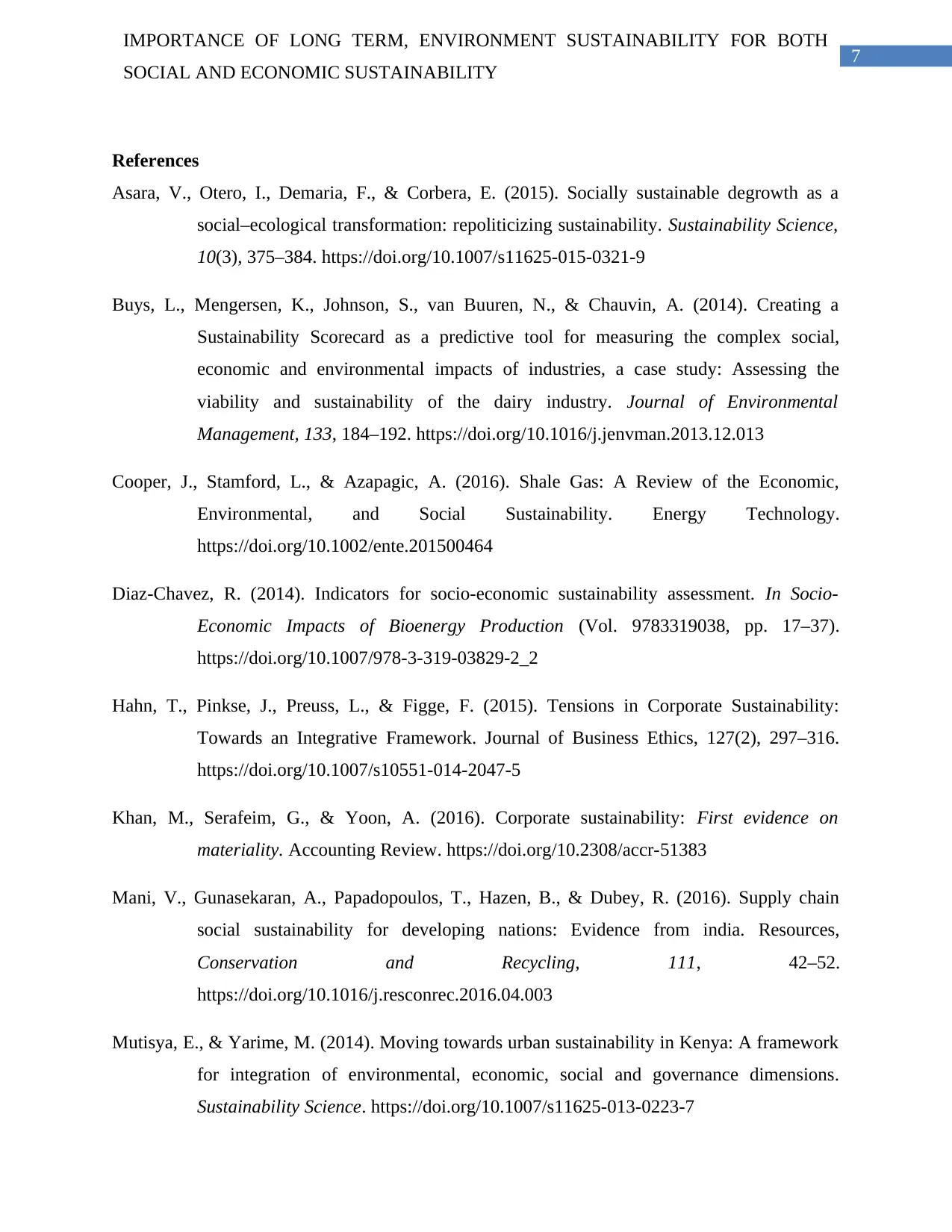
7
IMPORTANCE OF LONG TERM, ENVIRONMENT SUSTAINABILITY FOR BOTH
SOCIAL AND ECONOMIC SUSTAINABILITY
References
Asara, V., Otero, I., Demaria, F., & Corbera, E. (2015). Socially sustainable degrowth as a
social–ecological transformation: repoliticizing sustainability. Sustainability Science,
10(3), 375–384. https://doi.org/10.1007/s11625-015-0321-9
Buys, L., Mengersen, K., Johnson, S., van Buuren, N., & Chauvin, A. (2014). Creating a
Sustainability Scorecard as a predictive tool for measuring the complex social,
economic and environmental impacts of industries, a case study: Assessing the
viability and sustainability of the dairy industry. Journal of Environmental
Management, 133, 184–192. https://doi.org/10.1016/j.jenvman.2013.12.013
Cooper, J., Stamford, L., & Azapagic, A. (2016). Shale Gas: A Review of the Economic,
Environmental, and Social Sustainability. Energy Technology.
https://doi.org/10.1002/ente.201500464
Diaz-Chavez, R. (2014). Indicators for socio-economic sustainability assessment. In Socio-
Economic Impacts of Bioenergy Production (Vol. 9783319038, pp. 17–37).
https://doi.org/10.1007/978-3-319-03829-2_2
Hahn, T., Pinkse, J., Preuss, L., & Figge, F. (2015). Tensions in Corporate Sustainability:
Towards an Integrative Framework. Journal of Business Ethics, 127(2), 297–316.
https://doi.org/10.1007/s10551-014-2047-5
Khan, M., Serafeim, G., & Yoon, A. (2016). Corporate sustainability: First evidence on
materiality. Accounting Review. https://doi.org/10.2308/accr-51383
Mani, V., Gunasekaran, A., Papadopoulos, T., Hazen, B., & Dubey, R. (2016). Supply chain
social sustainability for developing nations: Evidence from india. Resources,
Conservation and Recycling, 111, 42–52.
https://doi.org/10.1016/j.resconrec.2016.04.003
Mutisya, E., & Yarime, M. (2014). Moving towards urban sustainability in Kenya: A framework
for integration of environmental, economic, social and governance dimensions.
Sustainability Science. https://doi.org/10.1007/s11625-013-0223-7
IMPORTANCE OF LONG TERM, ENVIRONMENT SUSTAINABILITY FOR BOTH
SOCIAL AND ECONOMIC SUSTAINABILITY
References
Asara, V., Otero, I., Demaria, F., & Corbera, E. (2015). Socially sustainable degrowth as a
social–ecological transformation: repoliticizing sustainability. Sustainability Science,
10(3), 375–384. https://doi.org/10.1007/s11625-015-0321-9
Buys, L., Mengersen, K., Johnson, S., van Buuren, N., & Chauvin, A. (2014). Creating a
Sustainability Scorecard as a predictive tool for measuring the complex social,
economic and environmental impacts of industries, a case study: Assessing the
viability and sustainability of the dairy industry. Journal of Environmental
Management, 133, 184–192. https://doi.org/10.1016/j.jenvman.2013.12.013
Cooper, J., Stamford, L., & Azapagic, A. (2016). Shale Gas: A Review of the Economic,
Environmental, and Social Sustainability. Energy Technology.
https://doi.org/10.1002/ente.201500464
Diaz-Chavez, R. (2014). Indicators for socio-economic sustainability assessment. In Socio-
Economic Impacts of Bioenergy Production (Vol. 9783319038, pp. 17–37).
https://doi.org/10.1007/978-3-319-03829-2_2
Hahn, T., Pinkse, J., Preuss, L., & Figge, F. (2015). Tensions in Corporate Sustainability:
Towards an Integrative Framework. Journal of Business Ethics, 127(2), 297–316.
https://doi.org/10.1007/s10551-014-2047-5
Khan, M., Serafeim, G., & Yoon, A. (2016). Corporate sustainability: First evidence on
materiality. Accounting Review. https://doi.org/10.2308/accr-51383
Mani, V., Gunasekaran, A., Papadopoulos, T., Hazen, B., & Dubey, R. (2016). Supply chain
social sustainability for developing nations: Evidence from india. Resources,
Conservation and Recycling, 111, 42–52.
https://doi.org/10.1016/j.resconrec.2016.04.003
Mutisya, E., & Yarime, M. (2014). Moving towards urban sustainability in Kenya: A framework
for integration of environmental, economic, social and governance dimensions.
Sustainability Science. https://doi.org/10.1007/s11625-013-0223-7
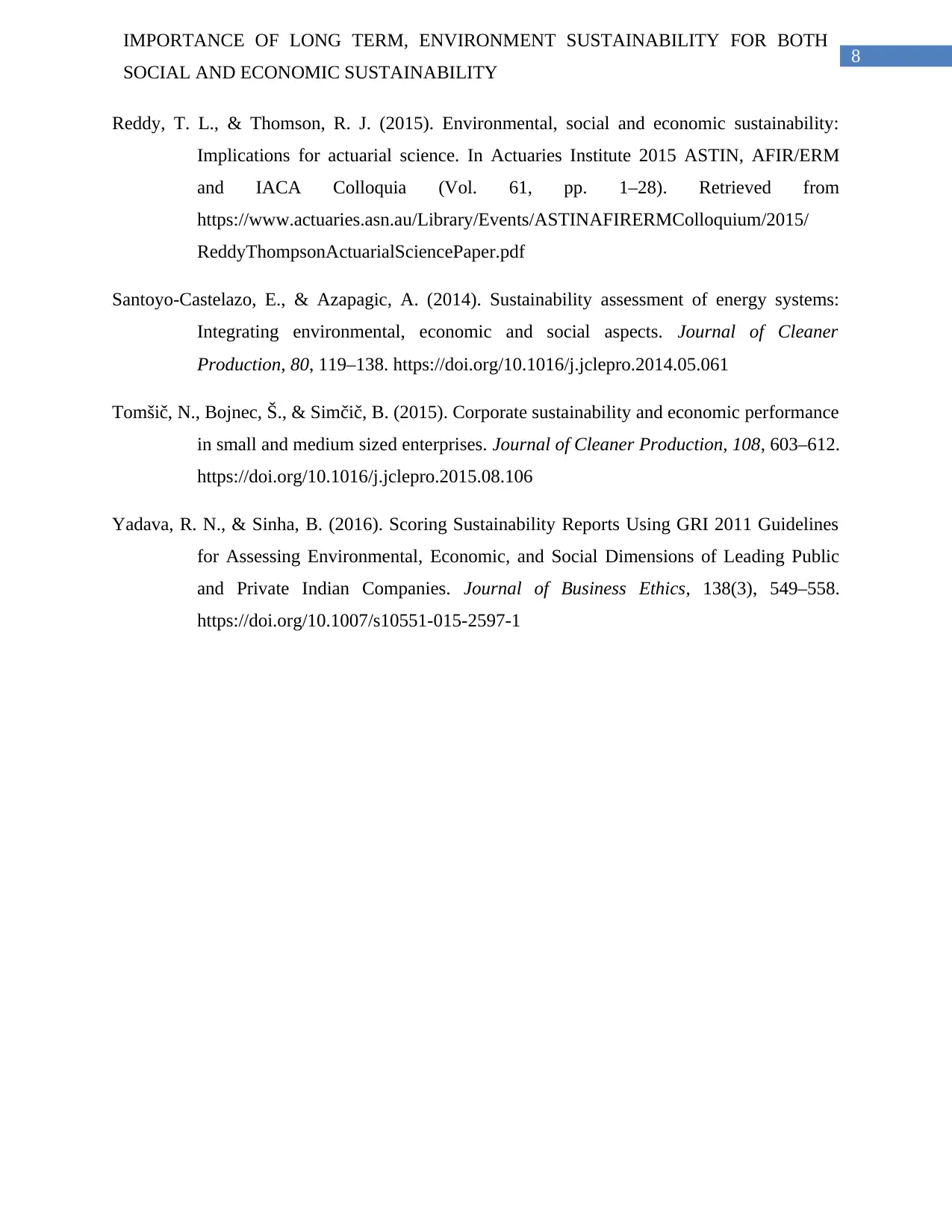
8
IMPORTANCE OF LONG TERM, ENVIRONMENT SUSTAINABILITY FOR BOTH
SOCIAL AND ECONOMIC SUSTAINABILITY
Reddy, T. L., & Thomson, R. J. (2015). Environmental, social and economic sustainability:
Implications for actuarial science. In Actuaries Institute 2015 ASTIN, AFIR/ERM
and IACA Colloquia (Vol. 61, pp. 1–28). Retrieved from
https://www.actuaries.asn.au/Library/Events/ASTINAFIRERMColloquium/2015/
ReddyThompsonActuarialSciencePaper.pdf
Santoyo-Castelazo, E., & Azapagic, A. (2014). Sustainability assessment of energy systems:
Integrating environmental, economic and social aspects. Journal of Cleaner
Production, 80, 119–138. https://doi.org/10.1016/j.jclepro.2014.05.061
Tomšič, N., Bojnec, Š., & Simčič, B. (2015). Corporate sustainability and economic performance
in small and medium sized enterprises. Journal of Cleaner Production, 108, 603–612.
https://doi.org/10.1016/j.jclepro.2015.08.106
Yadava, R. N., & Sinha, B. (2016). Scoring Sustainability Reports Using GRI 2011 Guidelines
for Assessing Environmental, Economic, and Social Dimensions of Leading Public
and Private Indian Companies. Journal of Business Ethics, 138(3), 549–558.
https://doi.org/10.1007/s10551-015-2597-1
IMPORTANCE OF LONG TERM, ENVIRONMENT SUSTAINABILITY FOR BOTH
SOCIAL AND ECONOMIC SUSTAINABILITY
Reddy, T. L., & Thomson, R. J. (2015). Environmental, social and economic sustainability:
Implications for actuarial science. In Actuaries Institute 2015 ASTIN, AFIR/ERM
and IACA Colloquia (Vol. 61, pp. 1–28). Retrieved from
https://www.actuaries.asn.au/Library/Events/ASTINAFIRERMColloquium/2015/
ReddyThompsonActuarialSciencePaper.pdf
Santoyo-Castelazo, E., & Azapagic, A. (2014). Sustainability assessment of energy systems:
Integrating environmental, economic and social aspects. Journal of Cleaner
Production, 80, 119–138. https://doi.org/10.1016/j.jclepro.2014.05.061
Tomšič, N., Bojnec, Š., & Simčič, B. (2015). Corporate sustainability and economic performance
in small and medium sized enterprises. Journal of Cleaner Production, 108, 603–612.
https://doi.org/10.1016/j.jclepro.2015.08.106
Yadava, R. N., & Sinha, B. (2016). Scoring Sustainability Reports Using GRI 2011 Guidelines
for Assessing Environmental, Economic, and Social Dimensions of Leading Public
and Private Indian Companies. Journal of Business Ethics, 138(3), 549–558.
https://doi.org/10.1007/s10551-015-2597-1
⊘ This is a preview!⊘
Do you want full access?
Subscribe today to unlock all pages.

Trusted by 1+ million students worldwide
1 out of 9
Related Documents
Your All-in-One AI-Powered Toolkit for Academic Success.
+13062052269
info@desklib.com
Available 24*7 on WhatsApp / Email
![[object Object]](/_next/static/media/star-bottom.7253800d.svg)
Unlock your academic potential
Copyright © 2020–2025 A2Z Services. All Rights Reserved. Developed and managed by ZUCOL.





